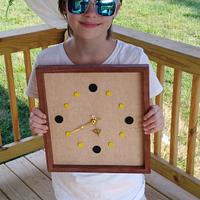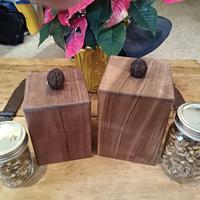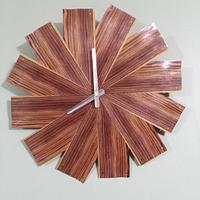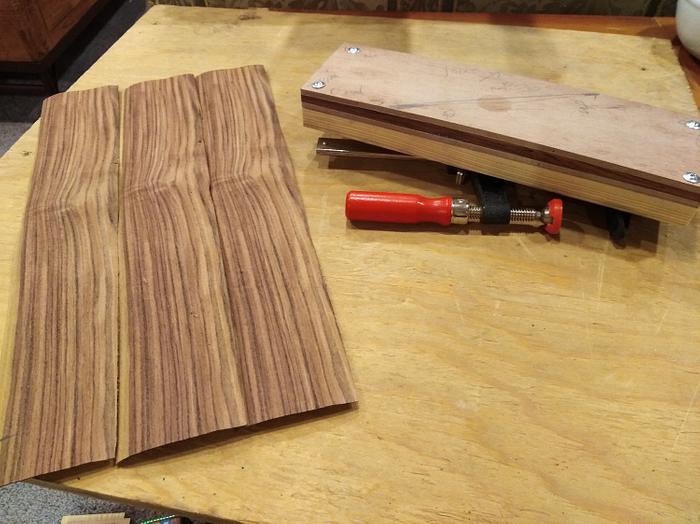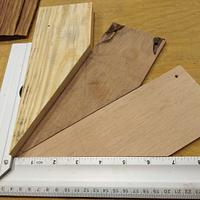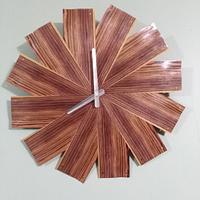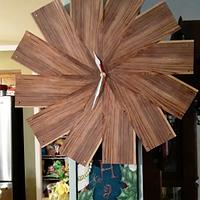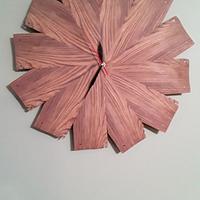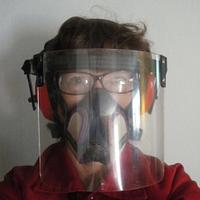Karson
in almost 12 years
More from Karson
Kingwood Veneer Clocks
I was getting ready to make a veneer presentation to my woodworking club in Lynchburg Virginia. And I want to make some demonstrations of things that you can do with veneer. Some of the items were showing what not to do, and others to show pleasing matches through using veneer.
I also want to try a practice of making a Demilune Table, but not making the table. What I wanted to do was join veneer in a circle or a half circle as you might do in the side table. I then thought of a clock with 12 slices of veneer, 1 sheet for each 5 minutes.
The veneer that I selected was some Kingwood veneer that I have had for a few years. I select a flitch that had 30 sheets and were about 3 1/2 inches wide and about 30 inches long. I determined by some practice of drawing on a sheet of plywood that each sheet should be about 9 inches long. So I selected 12 sheets that were in sequence and about 21 inches long as shown in picture 1. I sandwiched them between 2 sheets of 1/4 inch plywood so they wouldn’t move while sawing them. After making that sandwich I found that they still bowed so I screwed on a sheet of 3/4 inch wood. They were screwed at the end as you can see in picture 2. The 21 Inch packet was cut in half at 10 1/2 and the 10 1/2 inch packet was cut at 30 degrees. As you can see in the picture 1 that the veneer had a white stripe on one side. That long white stripe would point to the position where the number should be. the other piece after the 30 degree cut had the short side with the white stripe. Picture 1 has a picture of the packet and some of the veneer that went into the selection of the Kingwood Veneer. The packet pictured had already been cut from 21 inches to 10 1/2 inches but shows the layering of support woods to keep the packet together and also minimize the splitting on the cut surface. The burn marks on picture 2 show the ground off surface to shorten the extra length of the screws to keep them from hitting the table saw surface.
To make this thing work they had to be sawed at exactly 30 degrees. (The approximate line of the cut is seen in Picture 1.) Any more or any less they wouldn’t fit together as a circle. The three pieces shown in picture 2 proved that I didn’t cut at exactly at 30 degrees. After some modifications I got the exactly correct angle. To hold the packet and to cut the 30 degree section, I made a scrap piece of plywood at 60 degrees and then supported the packet against it. The cut was made at 90 degrees on the saw. 3 sheets made a 90 degree and they had to fit together as they were being veneer taped. I did them in groups of three and then did the three to make six then 2 sixes to make the 12.
I knew that putting the 12 sheets in a circle would mean that sheet 1 would match up to sheet 12 and I didn’t want a difference of wood variations to be noticeable. So I did odd sheets on one side and even sheets on the other. That way there was only 1 sheet difference between the sheets. So the sheets were numbered and it went like this 1, 3, 5, 7, 9, 11, 12, 10, 8, 6, 4, 2. So sheets 1 and 2 were at the 12 o’clock position and sheets 11 and 12 were at the 6 o’clock position.
I glued the veneer on a sheet of plywood over the section that was covered by the veneer. My original intention was to make the clock round, but, my wife thought she liked it better with the long sheets floating out into space. You can still see the screw holes at the end of the veneer sheet. They won’t be removed. So those 12 sheets of veneer ended up making 4 clocks.
Pictures 3 and 4 show the difference where the white stripe ended up. The actual end of the of the last one shows it didn’t have a white stripe at all, picture 5. The 4th clock had already exited the premises.
The presentation went over well and everyone got the chance to take home some veneer to practice with if they wanted to.
Wood is good
1 Comment
Karson,
That was a clever way to show off such lovely veneer. The grain in picture #4 really makes an interesting pinwheel at the center. Sounds like a very beneficial demonstration.
L/W
“Those who would give up essential Liberty, to purchase a little temporary Safety, deserve neither Liberty nor Safety.” Benjamin Franklin









